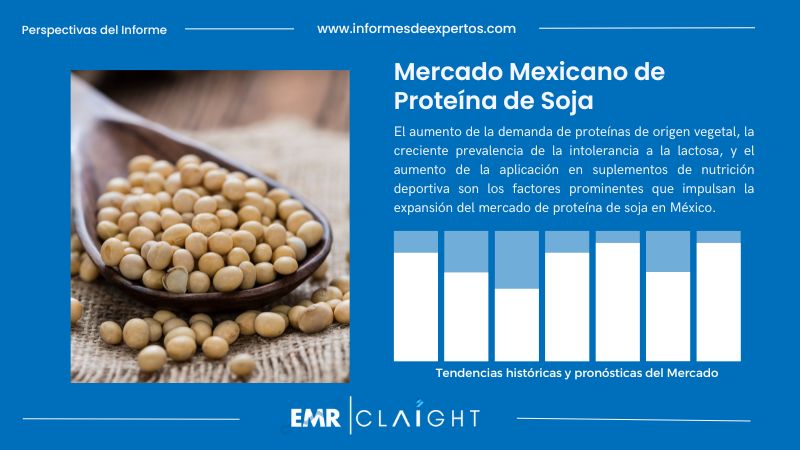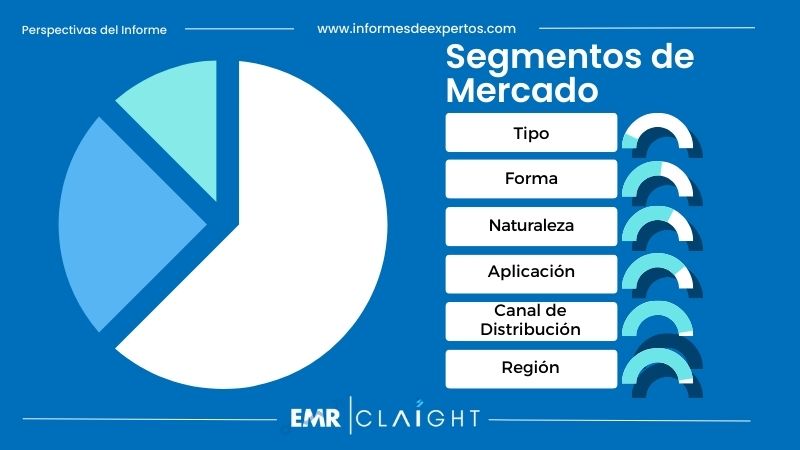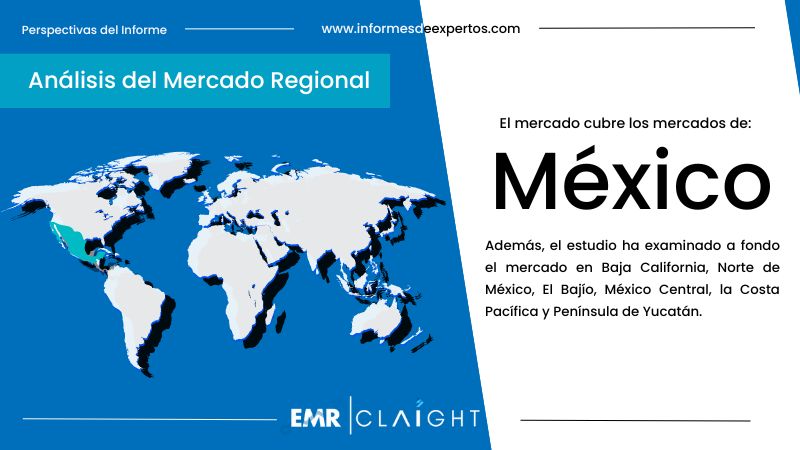Informes

Mercado Mexicano de Proteína de Soja – Por Tipo (Aislado, Texturizado/Hidrolizado, Concentrado); Por Forma (Polvo, Cápsulas y Comprimidos, Listo para Beber, Barritas, Otros); Por Naturaleza (Orgánico, Convencional); Por Aplicación (Panadería y Confitería, Alimentos Funcionales, Productos Farmacéuticos, Piensos, Aditivos Cárnicos); Por Canal de Distribución (Supermercados e Hipermercados, Tiendas de Conveniencia, Tiendas Especializadas, En Línea, Otros); Por Región (Baja California, Northern Mexico, El Bajío, México Central, Costa del Pacífico y Península de Yucatán); Dinámica del Mercado, Panorama Competitivo
Perspectiva del Mercado Mexicano de Proteína de Soja
El mercado mexicano de proteína de soja alcanzó un valor de alrededor de USD 187,28 millones en 2025. Se prevé que el mercado crezca a una tasa de crecimiento anual compuesta del 8,20% entre 2026 y 2035, para alcanzar un valor de 380,35 millones de USD en 2035.

Informe de muestra gratuito con índice: Obtenga un informe de muestra gratuito con tabla de contenido
La proteína de soja es una proteína vegetal que se obtiene de la soja. Su alto valor nutricional se debe a la riqueza de proteínas, folato, vitamina C, fibra, calcio, fósforo, potasio, hierro, etc. Además, dado que cumple con todos los requisitos esenciales de aminoácidos, ya que contiene 9 aminoácidos, a menudo se le conoce como una proteína completa. Siendo bajo en colesterol y grasa saturada, sirve como la alternativa más viable a los productos a base de carne.
Algunos factores prominentes que contribuyen al crecimiento del mercado de proteína de soja en México son la creciente inclinación de la gente hacia las dietas basadas en plantas y el aumento de la preocupación por la seguridad de los animales. Además, el veganismo cada vez está ganando más terreno, lo cual está aumentando la demanda de la proteína de soja. Lo interesante es que hoy en día hay mucha consciencia entre la población mexicana sobre los efectos negativos del estilo de vida sedentaria. Por lo tanto, se ve como una tendencia la creciente inclinación hacia los deportes, el yoga y la dieta saludable que incluye dieta basada en plantas. Otra tendencia importante es la creciente intolerancia a la lactosa entre la población mexicana que también está estimulando la demanda de proteína de soja en el país.

Informe de muestra gratuito con índice: Obtenga un informe de muestra gratuito con tabla de contenido
La Proteína de Soja: Segmentación del Mercado
En función del tipo, el mercado se divide en:
- Aislado
- Texturizado/Hidrolizado
- Concentrado
Según la forma, el mercado se clasifica en:
- Polvo
- Cápsulas y Comprimidos
- Listo para Beber
- Barritas
- Otros
Sobre la base de la naturaleza, el mercado se fragmenta en:
- Orgánico
- Convencional
En función de la aplicación, el mercado se segmenta en:
- Panadería y Confitería
- Alimentos Funcionales
- Productos Farmacéuticos
- Piensos
- Aditivos Cárnicos
Por canales de distribución, el mercado se clasifica en:
- Supermercados e Hipermercados
- Tiendas de Conveniencia
- Tiendas Especializadas
- En Línea
- Otros
Por región, el mercado de proteína de soja en México se clasifica en:
- Baja California
- Norte de México
- El Bajío
- México Central
- Costa del Pacífico
- Península de Yucatán

Informe de muestra gratuito con índice: Obtenga un informe de muestra gratuito con tabla de contenido
La creciente tendencia al veganismo y los casos de intolerancia a la lactosa impulsan el mercado de la proteína de soja en México
El mercado registra un crecimiento significativo debido al creciente interés de los consumidores por una dieta sana y basada en plantas y a la creciente inclinación hacia estilos de vida saludables. El aumento de las tendencias de salud y forma física, especialmente entre las generaciones más jóvenes, y la demanda de bebidas con alto contenido proteico ofrecen importantes oportunidades de crecimiento para el mercado de la proteína de soja en la región.
Además, los factores más destacados que impulsan la demanda de proteína de soja son el creciente veganismo y la intolerancia a la lactosa entre la población mexicana. Se calcula que alrededor del 20% de la población mexicana se identifica como vegetariana o vegana. Además, es la generación más joven la que impulsa el cambio hacia el veganismo, ya que está más preocupada por el bienestar animal y las cuestiones medioambientales. Aparte de esto, la importancia de la proteína de soja en la alimentación animal y la mayor concienciación sobre la dieta animal en la industria ganadera también impulsan el mercado de proteína de soja en el país.
Principales Empresas del Mercado de Proteína de Soja en México
Las empresas clave del mercado son Cargill, Inc., Archer-Daniels-Midland Co., Ajinomoto Co Inc., Bunge Global SA, Wilmar International Ltd., y Kerry Group Plc, entre otras.
Las bases de datos incluidas en el informe sobre el mercado de proteína de soja en México proporcionan importantes impactos en el desarrollo presentadas por las principales empresas, teniendo en cuenta sus ingresos. Este informe consta de los valores del período histórico (2019-2025) y del período de pronóstico (2026-2035) con patrones de evaluación ampliados que se llevan a cabo mediante el análisis IDE basado en tipo, forma, naturaleza, aplicación, canal de distribución y región del mercado para determinar el movimiento del estudio.
Además, el proyecto estudiado y analizado se basa en información detallada sobre el modelo de las cinco fuerzas de Porter, las estrategias de los principales actores existentes y sus carteras con diferenciación beneficiosa en innovación de productos en la industria. Por lo tanto, se concluye que el análisis del poder de negociación de los compradores, el poder adquisitivo de los consumidores, la amenaza de los sustitutos y la nueva entrada con el efecto de la reactivación y el desarrollo económicos se evalúa para subrayar el poderoso impacto en el mercado.
Preguntas Clave Respondidas en Este Informe:
- ¿Cuál es el rendimiento actual y la trayectoria proyectada del mercado mexicano de proteína de soja?
- ¿Cuáles son los principales impulsores, oportunidades y retos para el mercado mexicano de proteína de soja?
- ¿Cómo afecta cada impulsor, restricción y oportunidad al mercado mexicano de proteína de soja?
- ¿Cuáles son los principales mercados regionales estudiados en el informe?
- ¿Cuál es la región líder en el mercado mexicano de proteína de soja?
- ¿Qué factores contribuyen al dominio de esta región en el mercado mexicano de proteína de soja?
- ¿Cuál es la tasa de crecimiento histórica del mercado mexicano de proteína de soja en los últimos años?
- ¿Cuáles son sus respectivas fortalezas y enfoques de mercado?
- ¿Cómo contribuyen estas empresas a la dinámica general del mercado mexicano de proteína de soja?
- ¿Cuál es la estructura competitiva del merca do?
- ¿Quiénes son los principales actores del mercado mexicano de proteína de soja?
Beneficios Clave para las Partes Interesadas:
- El informe de la industria de IDE ofrece un análisis cuantitativo exhaustivo de varios segmentos del mercado, las tendencias históricas y actuales del mercado, las previsiones del mercado y la dinámica del mercado mexicano de proteína de soja de 2019 a 2035.
- El informe ofrece los datos más recientes sobre los impulsores, retos y oportunidades del mercado. El informe traza los principales mercados regionales, así como los que registran la tasa de crecimiento más rápida. Además, permite a las partes interesadas identificar los principales mercados nacionales de cada región.
- El análisis de las cinco fuerzas de Porter ayuda a las partes interesadas a evaluar el impacto de los nuevos operadores, la rivalidad competitiva, el poder del proveedor, el poder del comprador y la amenaza de sustitución. Ayuda a las partes interesadas a analizar el nivel de competencia en la industria de mexicano de proteína de soja y su atractivo.
- El panorama competitivo permite a las partes interesadas comprender su entorno competitivo y ofrece una visión de las posiciones actuales de los principales actores del mercado.
Alcance del Mercado:
|
Características del Informe |
Detalles |
|
Año Base de la Estimación: |
2025 |
|
Datos Históricos: |
2019-2025 |
|
Datos de Pronóstico: |
2026-2035 |
|
Alcance del Informe: |
Tendencias Históricas y Previsiones del Mercado, Impulsores y Limitantes de
|
|
Desglose por Tipo: |
|
|
Desglose por Forma: |
|
|
Desglose por Naturaleza: |
|
|
Desglose por Aplicación: |
|
|
Desglose por |
|
|
Desglose por Región: |
|
|
Dinámica del Mercado: |
|
|
Panorama Competitivo: |
|
|
Empresas Cubrietas: |
|
Informes de tendencias:
Mercado Latinoamericano de Vidrio Plano
Mercado de Cosméticos en Uruguay
Mercado de Bicicletas en Colombia
*En Informes de Expertos siempre nos esforzamos por brindarle la información más reciente. Los números de artículo son solo indicativos y pueden diferir del informe real.
Language of the Report – English
Sin embargo, el informe puede estar disponible en español por un costo adicional.
1 Preface
2 Report Coverage – Key Segmentation and Scope
3 Report Description
3.1 Market Definition and Outlook
3.2 Properties and Applications
3.3 Market Analysis
3.4 Key Players
4 Key Assumptions
5 Executive Summary
5.1 Overview
5.2 Key Drivers
5.3 Key Developments
5.4 Competitive Structure
5.5 Key Industrial Trends
6 Market Snapshot
7 Opportunities and Challenges in the Market
8 Latin America Soy Protein Market Overview
8.1 Key Industry Highlights
8.2 Latin America Soy Protein Historical Market (2019-2025)
8.3 Latin America Soy Protein Market Forecast (2026-2035)
9 Mexico Soy Protein Market Overview
9.1 Key Industry Highlights
9.2 Mexico Soy Protein Historical Market (2019-2025)
9.3 Mexico Soy Protein Market Forecast (2026-2035)
10 Mexico Soy Protein Market by Type
10.1 Isolate
10.1.1 Historical Trend (2019-2025)
10.1.2 Forecast Trend (2026-2035)
10.2 Textured/Hydrolyzed
10.2.1 Historical Trend (2019-2025)
10.2.2 Forecast Trend (2026-2035)
10.3 Concentrate
10.3.1 Historical Trend (2019-2025)
10.3.2 Forecast Trend (2026-2035)
11 Mexico Soy Protein Market by Form
11.1 Powder
11.1.1 Historical Trend (2019-2025)
11.1.2 Forecast Trend (2026-2035)
11.2 Capsules and Tablets
11.2.1 Historical Trend (2019-2025)
11.2.2 Forecast Trend (2026-2035)
11.3 Ready-to-Drink
11.3.1 Historical Trend (2019-2025)
11.3.2 Forecast Trend (2026-2035)
11.4 Bars
11.4.1 Historical Trend (2019-2025)
11.4.2 Forecast Trend (2026-2035)
11.5 Others
12 Mexico Soy Protein Market by Nature
12.1 Organic
12.1.1 Historical Trend (2019-2025)
12.1.2 Forecast Trend (2026-2035)
12.2 Conventional
12.2.1 Historical Trend (2019-2025)
12.2.2 Forecast Trend (2026-2035)
13 Mexico Soy Protein Market by Application
13.1 Bakery and Confectionery
13.1.1 Historical Trend (2019-2025)
13.1.2 Forecast Trend (2026-2035)
13.2 Functional Foods
13.2.1 Historical Trend (2019-2025)
13.2.2 Forecast Trend (2026-2035)
13.3 Pharmaceuticals
13.3.1 Historical Trend (2019-2025)
13.3.2 Forecast Trend (2026-2035)
13.4 Feed
13.4.1 Historical Trend (2019-2025)
13.4.2 Forecast Trend (2026-2035)
13.5 Meat Additives
13.5.1 Historical Trend (2019-2025)
13.5.2 Forecast Trend (2026-2035)
13.6 Others
14 Mexico Soy Protein Market by Distribution Channel
14.1 Supermarkets and Hypermarkets
14.1.1 Historical Trend (2019-2025)
14.1.2 Forecast Trend (2026-2035)
14.2 Convenience Stores
14.2.1 Historical Trend (2019-2025)
14.2.2 Forecast Trend (2026-2035)
14.3 Specialty Stores
14.3.1 Historical Trend (2019-2025)
14.3.2 Forecast Trend (2026-2035)
14.4 Online
14.4.1 Historical Trend (2019-2025)
14.4.2 Forecast Trend (2026-2035)
14.5 Others
15 Mexico Soy Protein Market by Region
15.1 Baja California
15.1.1 Historical Trend (2019-2025)
15.1.2 Forecast Trend (2026-2035)
15.2 Northern Mexico
15.2.1 Historical Trend (2019-2025)
15.2.2 Forecast Trend (2026-2035)
15.3 The Bajío
15.3.1 Historical Trend (2019-2025)
15.3.2 Forecast Trend (2026-2035)
15.4 Central Mexico
15.4.1 Historical Trend (2019-2025)
15.4.2 Forecast Trend (2026-2035)
15.5 Pacific Coast
15.5.1 Historical Trend (2019-2025)
15.5.2 Forecast Trend (2026-2035)
15.6 Yucatan Peninsula
15.6.1 Historical Trend (2019-2025)
15.6.2 Forecast Trend (2026-2035)
16 Market Dynamics
16.1 SWOT Analysis
16.1.1 Strengths
16.1.2 Weaknesses
16.1.3 Opportunities
16.1.4 Threats
16.2 Porter’s Five Forces Analysis
16.2.1 Supplier’s Power
16.2.2 Buyer’s Power
16.2.3 Threat of New Entrants
16.2.4 Degree of Rivalry
16.2.5 Threat of Substitutes
16.3 Key Indicators for Demand
16.4 Key Indicators for Price
17 Competitive Landscape
17.1 Market Structure
17.2 Company Profiles
17.2.1 Cargill, Inc.
17.2.1.1 Company Overview
17.2.1.2 Product Portfolio
17.2.1.3 Demographic Reach and Achievements
17.2.1.4 Certifications
17.2.2 Archer-Daniels-Midland Co.
17.2.2.1 Company Overview
17.2.2.2 Product Portfolio
17.2.2.3 Demographic Reach and Achievements
17.2.2.4 Certifications
17.2.3 Ajinomoto Co Inc.
17.2.3.1 Company Overview
17.2.3.2 Product Portfolio
17.2.3.3 Demographic Reach and Achievements
17.2.3.4 Certifications
17.2.4 Bunge Global SA
17.2.4.1 Company Overview
17.2.4.2 Product Portfolio
17.2.4.3 Demographic Reach and Achievements
17.2.4.4 Certifications
17.2.5 Wilmar International Ltd.
17.2.5.1 Company Overview
17.2.5.2 Product Portfolio
17.2.5.3 Demographic Reach and Achievements
17.2.5.4 Certifications
17.2.6 Kerry Group Plc
17.2.6.1 Company Overview
17.2.6.2 Product Portfolio
17.2.6.3 Demographic Reach and Achievements
17.2.6.4 Certifications
17.2.7 Others
18 Key Trends and Developments in the Market
List of Key Figures and Tables
1. Latin America Soy Protein Market: Key Industry Highlights, 2019 and 2035
2. Mexico Soy Protein Market: Key Industry Highlights, 2019 and 2035
3. Mexico Soy Protein Historical Market: Breakup by Type (USD Million), 2019-2025
4. Mexico Soy Protein Market Forecast: Breakup by Type (USD Million), 2026-2035
5. Mexico Soy Protein Historical Market: Breakup by Form (USD Million), 2019-2025
6. Mexico Soy Protein Market Forecast: Breakup by Form (USD Million), 2026-2035
7. Mexico Soy Protein Historical Market: Breakup by Nature (USD Million), 2019-2025
8. Mexico Soy Protein Market Forecast: Breakup by Nature (USD Million), 2026-2035
9. Mexico Soy Protein Historical Market: Breakup by Application (USD Million), 2019-2025
10. Mexico Soy Protein Market Forecast: Breakup by Application (USD Million), 2026-2035
11. Mexico Soy Protein Historical Market: Breakup by Distribution Channel (USD Million), 2019-2025
12. Mexico Soy Protein Market Forecast: Breakup by Distribution Channel (USD Million), 2026-2035
13. Mexico Soy Protein Historical Market: Breakup by Region (USD Million), 2019-2025
14. Mexico Soy Protein Market Forecast: Breakup by Region (USD Million), 2026-2035
15. Mexico Soy Protein Market Structure
*The list of players in the competitive landscape section can be customised or made more exhaustive based on your specific requirements.*
¿Cuál fue el tamaño del mercado de proteína de soja en México en 2025?
En 2025, el mercado alcanzó un valor de USD 187,28 millones.
¿Cuál es la tasa de crecimiento del mercado?
Se prevé que el mercado crezca a una CAGR del 8,20% entre 2026 y 2035.
¿Cuál es la perspectiva de pronóstico del mercado de proteína de soja en México para 2026-2035?
Se estima que el mercado experimentará un crecimiento saludable en el período de pronóstico de 2026-2035 para alcanzar USD 380,35 millones en 2035.
¿Cuáles son los prominentes factores que impulsan la expansión del mercado?
El aumento de la demanda de proteínas de origen vegetal, la creciente prevalencia de la intolerancia a la lactosa, y el aumento de la aplicación en suplementos de nutrición deportiva son los factores prominentes que impulsan la expansión del mercado de proteína de soja en México.
¿Cuáles son las tendencias emergentes del mercado?
La creciente demanda de proteína de soja no transgénica y orgánica y la creciente aplicación en alimentos infantiles son las tendencias emergentes del mercado objetivo.
¿Cuáles son los principales mercados regionales de proteína de soja en México?
Las principales regiones consideradas en el informe son Baja California, Norte de México, El Bajío, México Central, la Costa Pacífica y Península de Yucatán.
¿Cómo se divide el mercado en función del tipo?
En función del tipo, el mercado se divide en aislado, texturizado, hidrolizado y concentrado.
¿Cuáles son las diferentes aplicaciones de la proteína de soja?
Las diferentes aplicaciones de la proteína de soja son panadería y confitería, productos farmacéuticos, alimentos funcionales, piensos y aditivos cárnicos, entre otros.
¿Quiénes son los principales actores en el mercado de proteína de soya en México?
Los principales actores del mercado son Cargill, Inc, Archer-Daniels-Midland Co, Ajinomoto Co Inc, Bunge Global SA, Wilmar International Ltd, y Kerry Group Plc, entre otros.
Excel Data Set
USD1799
-
Datos completos en formato Excel para un usuario
-
Impresión no permitida
-
Entrega por Email
-
Personalización limitada gratuita (pre-venta)Soporte de analista post ventaDescuento del 50% en la Próxima ActualizaciónUsuario Único
USD3199
USD2999-
Restringido a un usuario
-
Solo una impresión
-
Disponible en PDF
-
Personalización limitada gratuita (pre-venta)Soporte de analista post ventaDescuento del 50% en la Próxima ActualizaciónCinco Usuarios
USD4199
USD3999-
Restringido a cinco usuarios
-
Una impresión por usuario
-
Disponible en PDF
-
Personalización limitada gratuita (pre-venta)
-
Soporte de analista post venta
-
Descuento del 50% en la Próxima Actualización
Multiusuario
USD5199
USD4999-
Usuarios ilimitados dentro de la organización
-
Impresiones ilimitadas
-
Disponible en PDF
-
Personalización limitada gratuita (pre-venta)
-
Soporte de analista post venta
-
Descuento del 50% en la Próxima Actualización
Póngase en Contacto¿Cualquier Pregunta? Hable con un Analista
Solicitar una MuestraVer una Muestra
Solicitar PersonalizaciónSe le olvidó algo? Pregunte Ahora
¿Por qué Informes de Expertos?La Gente Adecuada
Somos técnicamente excelentes, estratégicos, prácticos, experimentados y eficientes; nuestros analistas son cuidadosamente seleccionados en función de tener los atributos correctos para trabajar con éxito y ejecutar proyectos basados en sus expectativas.
Metodología Correcta
Aprovechamos nuestra tecnología de vanguardia, nuestro acceso a bases de datos confiables y nuestro conocimiento de los modelos actuales utilizados en el mercado para ofrecerle soluciones de investigación que se adapten a sus necesidades y lo pongan a la vanguardia.
Precio Justo
Realizamos una investigación exhaustiva y de calidad superior a precios razonables, inigualables y que demuestran nuestra comprensión de su estructura de recursos. Además, ofrecemos descuentos atractivos en nuestros próximos informes.
Apoyo Adecuado
Nuestro equipo de analistas expertos está a su disposición entera para ofrecerle resultados óptimos personalizados para satisfacer sus necesidades precisas dentro del plazo especificado y ayudarlo a comprender mejor la industria.
Informes SimilaresEl aumento de la demanda basada en plantas, la certificación orgánica respaldada por el gobierno, la integración nutracéutica, el crecimiento impulsado por las exportaciones y la expansión de la ...
El aumento del consumo de productos de origen vegetal y de etiqueta limpia, la creciente demanda de nutrición deportiva, la adopción de alimentos funcionales, las iniciativas orgánicas respaldadas ...
Los principales factores que contribuyen al crecimiento del mercado global de suplementos alimenticios a base de hierbas son la creciente preferencia por productos naturales y de origen vegetal, el au...
El desarrollo del mercado mundial de nutracéuticos se está acelerando debido a varios factores, como el creciente envejecimiento de la población, la expansión de las plataformas de comercio electr...
El mercado de vitamina A en América Latina está creciendo constantemente debido al aumento de los casos de deficiencia de vitamina A, a la mayor conciencia sanitaria de la población, la creciente d...
Newsletter





